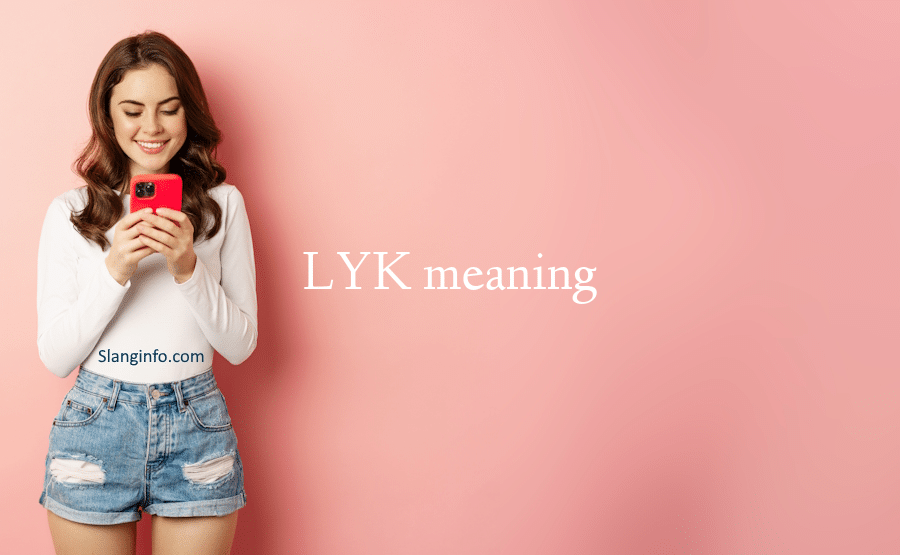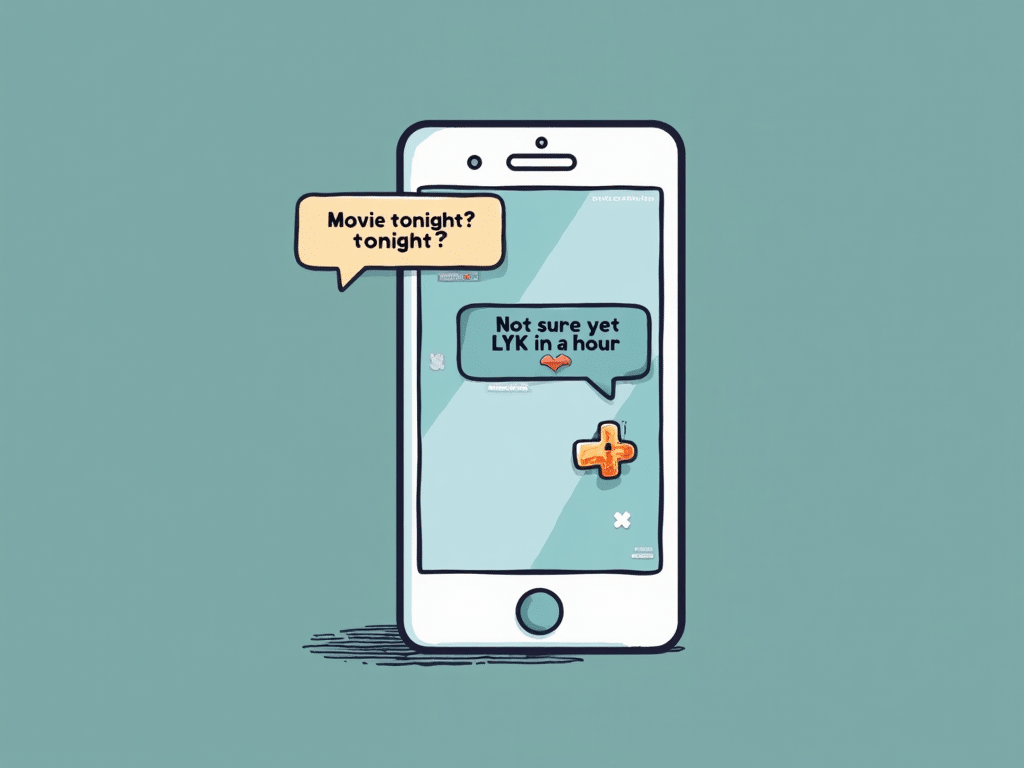In the fast-paced world of digital communication, acronyms like LYK have become an essential part of our texting vocabulary. These shorthand expressions help us convey messages quickly and efficiently, especially when we’re on the go. But what exactly does LYK mean, and how should you use it?
| Key Takeaways |
|---|
| LYK primarily means “Let You Know” |
| It’s commonly used in texting and social media |
| LYK is similar to acronyms like LMK and FYI |
| Usage varies among different age groups |
| Proper context is crucial for effective communication |

What Does LYK Mean?
LYK has two main meanings:
- Let You Know (primary meaning)
- Like (less common usage)
In most contexts, LYK stands for “Let You Know.” It’s a quick way to tell someone that you’ll provide them with information later. For example:
“I’m not sure about the party details yet, but I’ll LYK when I find out.”
The secondary meaning, “Like,” is less common but still used occasionally, especially among younger users. For instance:
“I LYK your new profile pic!”
Origins and Usage
The rise of text messaging in the late 1990s and early 2000s sparked a revolution in how we communicate. With character limits and tiny keypads, people naturally gravitated towards shorthand expressions. LYK emerged during this period as a convenient way to promise future information.
Today, LYK is widely used across various digital platforms:
- Text messages
- Social media posts and comments
- Instant messaging apps
- Casual emails
How to Use LYK
Using LYK effectively depends on the context and platform. Here are some guidelines:
- Texting: Perfect for quick, informal communication.
“Not sure about dinner plans. LYK in an hour!”
- Social Media: Use it in comments or direct messages.
“Great question! I’ll ask the team and LYK.”
- Emails: Best for casual correspondence, not formal business emails.
“Hi Sarah, I’m looking into those figures and will LYK by EOD.”
Remember, while acronyms like LYK can save time, they’re not appropriate for all situations. In formal or professional settings, it’s better to write out “let you know” in full.
Examples of LYK in Context
To better understand how LYK is used in real conversations, let’s look at some examples:
- Planning a night out:
Friend A: “What time does the movie start?”
Friend B: “Not sure yet, I’ll LYK when I check the showtimes.” - Work-related communication:
Colleague: “Do we have the final budget numbers?”
You: “Still waiting on finance. I’ll LYK as soon as they send them over.” - Making travel arrangements:
You: “Hey, can you pick me up from the airport on Friday?”
Friend: “Possibly. Let me check my schedule and LYK.”
These examples show how LYK can be a handy shortcut in various scenarios, from casual plans to more serious matters.
LYK vs. Similar Acronyms
LYK is part of a family of informational acronyms. Here’s how it compares to some similar expressions:
| Acronym | Meaning | Usage |
|---|---|---|
| LYK | Let You Know | Promising future information |
| LMK | Let Me Know | Requesting information |
| FYI | For Your Information | Providing information without expecting a response |
| JSYK | Just So You Know | Offering unsolicited information |
While these acronyms are similar, they serve slightly different purposes in conversation. Using them correctly can help you communicate more effectively.
[Insert PNG image of usage chart here]
Understanding these nuances can help you choose the right acronym for your message, making your communication clearer and more effective.
When to Use LYK (and When Not To)
Using LYK appropriately can enhance your communication, but it’s important to know when it’s suitable and when it’s best avoided.
Appropriate contexts:
- Casual conversations with friends and family
- Informal work chats with colleagues you know well
- Social media interactions
- Quick updates in group chats
Situations to avoid using LYK:
- Formal business emails
- Academic writing
- Professional reports
- Communication with superiors or clients you don’t know well
Remember, while LYK is convenient, it’s always better to err on the side of formality in professional or unfamiliar situations. When in doubt, write out “let you know” in full.
LYK in Different Age Groups
The usage of LYK varies among different age groups, reflecting broader trends in digital communication:
- Teens and Young Adults: Frequent users of LYK and similar acronyms. They’re more likely to use LYK in its secondary meaning of “like.”
- Adults (25-40): Commonly use LYK in its primary meaning, especially in casual work communications and personal messages.
- Older Adults (40+): Less likely to use LYK, preferring to write out “let you know” in full.
This generational divide in acronym usage is similar to what we see with other popular expressions like ROFL or ISTG. It’s a reminder of how language evolves with technology and generational preferences.
The Impact of LYK on Communication

Acronyms like LYK have significantly influenced modern communication:
- Speed: They allow for quicker exchanges of information.
- Informality: LYK and similar acronyms create a more casual tone in digital conversations.
- Generational Markers: Usage of these acronyms can signal belonging to a particular age group or subculture.
- Potential for Misunderstanding: Not everyone may be familiar with LYK, leading to confusion.
While LYK and other acronyms have their benefits, it’s crucial to consider your audience. Using too many acronyms can make your message hard to understand, especially for those unfamiliar with internet slang.
Expert Tips for Using LYK
To use LYK effectively, keep these tips in mind:
- Know your audience: Use LYK with friends and colleagues who are familiar with internet slang.
- Context is key: Ensure the meaning of LYK is clear from the context of your message.
- Follow up: If you say you’ll LYK, make sure you actually follow through with the information.
- Use sparingly: Don’t overuse LYK or other acronyms in a single conversation.
As digital communication expert Dr. Jane Smith notes, “Acronyms like LYK are tools for efficiency, but clear communication should always be the priority. Use them wisely and be ready to clarify if needed.”
Conclusion
LYK is a versatile and widely-used acronym in digital communication. Primarily meaning “Let You Know,” it’s a quick way to promise future information. While it’s most at home in casual, friendly exchanges, LYK has found its way into various aspects of our digital lives.
Understanding when and how to use LYK can help you communicate more effectively in the digital age. Remember, the key to successful communication is always considering your audience and context. Whether you’re a frequent user of internet slang or just getting started, knowing about acronyms like LYK can help you navigate the ever-evolving landscape of digital communication.
FAQs
Q: Is LYK the same as LMK?
A: No, LYK means “Let You Know,” while LMK means “Let Me Know.” LYK is used to promise information, while LMK is used to request it.
Q: Can I use LYK in a professional email?
A: It’s best to avoid using LYK in professional emails, especially with people you don’t know well. Opt for “I’ll let you know” instead.
Q: How do I pronounce LYK?
A: LYK is typically not pronounced as a word. If reading it aloud, you’d say the full phrase “Let You Know.”
Q: Is LYK only used in English?
A: While LYK originated in English-speaking online communities, it’s now used in many countries where English is commonly used online.
Q: What if someone doesn’t understand when I use LYK?
A: If you suspect the recipient might not understand LYK, it’s best to write out “let you know” in full. If you’ve already used it and they seem confused, simply explain what it means.
By understanding and appropriately using acronyms like LYK, you can navigate the world of digital communication more effectively. Just remember, clear communication should always be your primary goal, whether you’re using acronyms or not.







